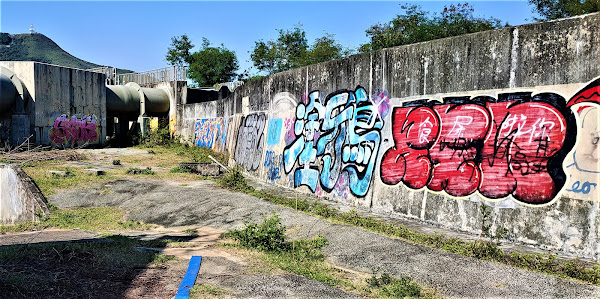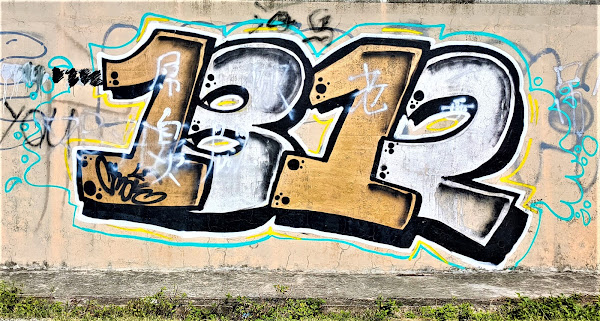Because I’ve been unable to do any cycling recently, Paula and I have been going on long walks, and the week before last we followed the Drainage Services Department (DSD) access road that runs alongside our local river (Ng Tung River) to the point where it reaches the main railway into China, where there is a tunnel under the line (followed by one of the most difficult ramps to negotiate on a bike). From the top of the ramp, the path passes underneath four gigantic pipes that bring water from China to Hong Kong to reach the DSD access road that runs alongside the Shek Sheung River, which the Ng Tung River joins hereabouts.
I just happened to notice what appeared to be some kind of artwork through a gap in the concrete supports for the water pipes, and of course I wanted to take a closer look. To my surprise, and delight, I discovered a wall that was covered in what I would characterize as ‘proper’ graffiti:
I should point out that we no longer cycle this way nowadays—not because the ramp is difficult, we simply found a better way ‘out west’—but none of this graffiti can be seen from the DSD access road that we now follow from its start. Given the attitude in Hong Kong towards graffiti, this is therefore a perfect location for graffiti artists, free from the certainty that their work will be washed off or painted over, sometimes within days of its execution, although the hidden nature of this location deprives them of an audience.
Unfortunately, although their work isn’t being destroyed, it is being defaced, possibly by other graffiti artists. Several of the tags here have had deeply offensive sexual insults sprayed on them. I’m not going to provide any translations, but if you can read Chinese, you may not want to continue reading, although I’m posting the few images of thus damaged graffiti because I don’t want to censor the work of the original artists.
The wall in the photo above curves outwards, so I wasn’t able to include the first tag on the right:
I’ve no idea what the significance of ‘1812’ is to the original artist, although Tchaikovsky wrote his 1812 Overture to commemorate Napoleon’s retreat from Moscow in that year. The turquoise and yellow lines are clearly part of the design and have been damaged by mindless vandals, but it is the white Chinese characters that I find especially annoying, and not just because they represent the worst insult that you can utter in Chinese. The dickhead responsible has ruined a beautifully executed graffito! The next photo also shows a vandalized graffito:
I interpret the overwriting as a gay slur directed at the artist, who is probably known to the person responsible for the slur. This tag is not particularly imaginative and is not among the best works here, although the red body colour appears to have been brushed with white rather than sprayed, which is unusual.
Written Chinese provides some interesting possibilities, as the next photo illustrates:
It reads ‘spray the wall like a crow’, which I interpret as an ironic comment on the process of graffiti creation. It has the glinting light motif that I’ve seen frequently in the graffiti of Europe but is unusual here. I would have liked to have seen this when it was first painted, because black mould has seriously damaged the colours.
The next photo also shows a graffito that has been damaged by black mould. It would have been quite striking when created:
I was surprised to discover that the next image along was a rather fine line drawing of a tree:
The next photo shows an extremely imaginative design:
Unfortunately, although the light and dark orange and white highlights have not been affected by the mould, the blue body colour probably wasn’t applied thickly enough and is now much the worse for wear.
The next work should have been painted on canvas and hung in a modern art museum:
I couldn’t get a good picture of the last image on this wall because of the water pipe, but I suspect that it was created by the same artist as the previous image, because the colours used are almost identical:
This is the isolated graffito on the concrete pipeline support that you can see in the first photo above:
As you can see, this well-executed graffito has been badly defaced. The repeated four-character phrase is a claim that the perpetrator has slept with (presumably) the artist’s wife. And who is Calvin? Clearly an arrogant sod, given that he has plastered his name repeatedly across someone else’s creation.
There were a few more graffiti on other concrete pipeline supports nearby. This one, also defaced by Calvin, and possibly by other people, appears to read ‘SHaK’:
This graffito, which appears to show the sun rising behind a figure in a sleeping bag, has also been defaced:
The three graffiti in the next photo may have been created quite recently, because the colours remain vibrant. I was surprised to find FuK1 here, although it is not an attempt to be rude. As I pointed out in Blessing or Curse?, fuk is Cantonese for ‘blessing’, and this tag has appeared half a dozen times in the Fanling industrial area recently, where the ‘1’ is an integral part of the design rather than an afterthought relegated to a speech bubble. A stylized version of the character for fuk appears in the bubble below. But why has the artist overwritten part of the graffito in the middle (Rza)? I consider this to be disrespectful, especially as Fuk1 appears in two other locations hereabouts, so it’s not as if there’s a shortage of space here. FLG also appears again (see below).
I like the gradual fade from purple to pink, the orange clubs and the way the artist has separated off parts of the lettering at the bottom of this tag:
The next image was probably created by a novice, and it would be interesting to see how the artist’s style develops, although I don’t expect to witness that:
Finally, I’m not sure what this graffito is meant to represent, but every time I look at it I think that there are two turn valves set into the structure:
* * *
Last week, I decided to revisit this location, because I thought that I might have missed something. I had.
The first thing I did was to take another look around the original wall. There was an obvious cul de sac to the right of 1812, and when I went down it, I discovered four well-executed graffiti. They were difficult to photograph, and all but the first of the next four photos were taken after I had climbed up onto the pipework here, using the ladder that you can see in the second photo.
I think that the artist responsible for the first tag is identifying himself as being from the UK:
All the FuK1 tags in the Fanling industrial area use the same lettering style, but this one is different, with its three-dimensional effect, which may indicate that ‘FuK1’ is some kind of motto for the entire graffiti artist community here, and this example was painted by a different artist:
If my conjecture that ‘23’ refers to the year of its creation is correct, then this (and the other graffiti next to it) are very recent.
It was impossible to take a better photo of the next graffito to the right, because of the cramped location:
The final tag here appears to be someone’s (presumably the artist’s) name in Chinese), although it’s almost impossible to make out precisely which characters are depicted, a property that it shares with graffiti artists who use the roman alphabet:
The squiggly lines may be intended to represent paint running, although the execution is quite crude compared with some of the graffiti I saw in Manchester.
While I was on top of the water pipe, I also took this photo of a graffito some distance away:
I’d seen it from the top of the ramp described above, but it was too far away to take a meaningful photo. This photo is also from distance, and the next time I pass this way, I will certainly look to see whether there is a way through the concrete jungle, not least because if I can locate such a passage, there may be more graffiti here.
Returning to the path, I couldn’t help but notice another FuK1, with other graffiti, about 20 metres to the south. Paula insisted that it had been there the previous week, but I’m not so sure. As I walked towards the graffiti I could see from the path, I spotted a few more graffiti under the pipe on the left. First, another UKER:
This one could have been intended to represent a lotus flower, or the element ‘fire’:
I can’t tell whether the two sides of the next photo were executed by the same artist, but the right-hand part is an imaginative rendition of the Chinese surname Man constructed to resemble a man:
And this is the wall that I could see clearly from the path:
As you can see, there is a second FLG and a third FuK1 here. I won’t attempt to read the tag in the middle, which is something new, although it looks as though some sweat was involved in its creation:
The FuK1 here may also have been created by a different artist. The standard lettering style has rounded corners, but here the corners are angular. And it’s also standard to use the same body colour throughout, although in Fanling I’ve seen different colours being used in different examples. Here, however, both light and dark blue have been used together:
And that’s the ‘secret’ graffiti gallery that I discovered a fortnight ago. I don’t expect the work here to be whitewashed by the authorities, but nature (the black mould) will reclaim these walls in a year or two. Meanwhile, this is another location, like The Bridge of Signs, that I will be checking from time to time, hoping to see new work.





























Great to read your description of graffitis, full of surprises
ReplyDeleteFor me, surprise is a key element of graffiti.
Deleteit is rather interesting to see these 'artistic' expressions, although we may not be able to interpret the actual intent of each expression.
ReplyDeleteThe number 1 after fuk is probably the tonal mark in Cantonese, so the character is 福 (I believe you know the word already.)
ReplyDeleteThe one which looks like a man is probably the phrase 虛妄 , which is a term used in Buddhism, same for the phrase 無明 on the left in the same picture. Both have an approximate meaning of "ignorance" so I suppose that fire symbol in the middle signifies enlightenment?
Again, thank you for taking the time to share these. They are all very interesting.
Thank you for such an informative comment. I was particularly intrigued by your linking some of the graffiti here to Buddhism. The two characters that you translate as ‘ignorance’ I had come up with the translation ‘delusion’, which is pretty close. By the way, it never occurred to me that the marks on the left-hand side of the photograph were stylized Chinese characters, but I could see them once you had pointed this out.
Delete